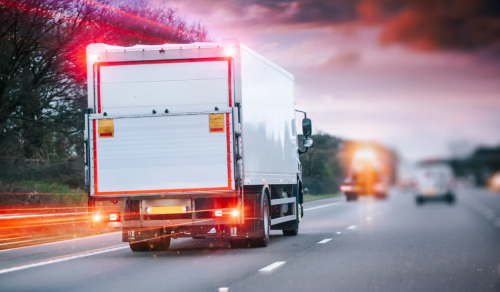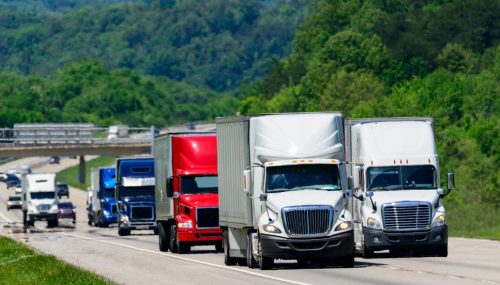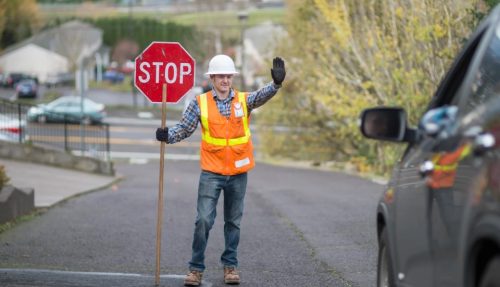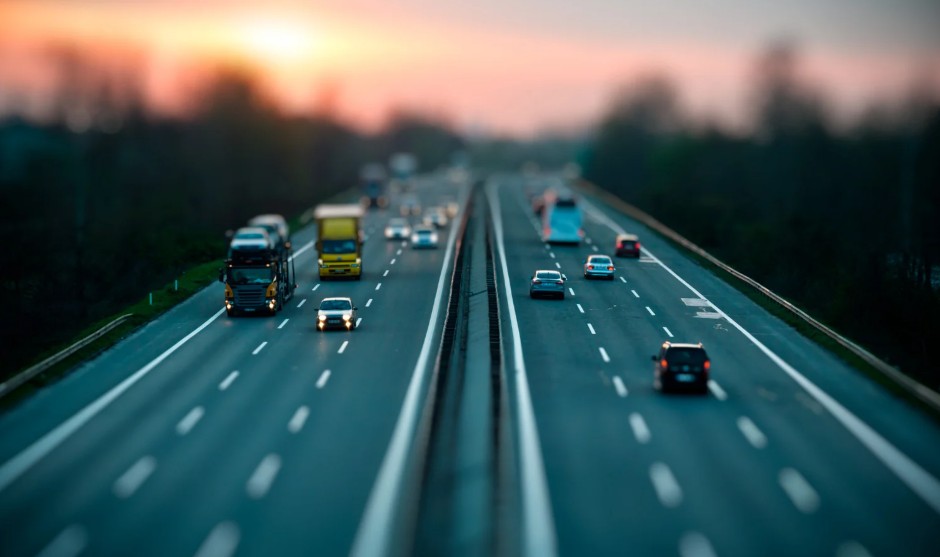Table of Contents
When driving on a motorway in the UK, you may come across a special lane designed for slow-moving vehicle, this is known as a crawler lane.
These lanes are strategically placed to improve traffic flow and safety on roads with steep inclines, allowing heavy goods vehicles (HGVs), lorries, and other slow-moving traffic to travel without obstructing faster-moving vehicles.
Understanding where would you find crawler lanes on a motorway, their purpose, and the rules for using them is crucial for all drivers.
This guide will explore everything you need to know about crawler lanes, including their locations, road signs, safety benefits, and legal regulations to help you drive more confidently on UK motorways.
What Is a Crawler Lane?

Image – Source
A crawler lane, also known as a climbing lane, is a dedicated lane on a motorway or dual carriageway designed for slow-moving and heavy vehicles.
These lanes are typically found on steep inclines where larger vehicles may struggle to maintain speed, helping to improve traffic flow and reduce congestion.
Unlike a standard lane, a crawler lane allows vehicles moving at slower speeds to separate from faster-moving traffic, reducing the risk of accidents and bottlenecks.
Drivers of cars, motorcycles, and other faster vehicles can continue driving without unnecessary delays, while HGVs, lorries, and caravans can safely travel at a lower speed without blocking the main lanes.
Crawler lanes are clearly marked with road signs and lane markings, instructing drivers when to use them.
They often appear at the start of an incline and merge back into the main carriageway once the slope levels out.
Why Is a Crawler Lane Used on Motorways?
Crawler lanes serve multiple purposes to ensure smoother traffic movement and enhanced road safety.
Key Benefits of Crawler Lanes
- Reduces congestion: By keeping slow-moving vehicles in a separate lane, faster traffic can continue without unnecessary disruptions.
- Enhances road safety: Prevents large vehicles from causing lane blockages, reducing accident risks.
- Supports heavy vehicles: Lorries, HGVs, and other vehicles with heavy loads can travel at safe speeds without obstructing other road users.
- Improves driving conditions: Reduces frustration among faster-moving drivers by providing a designated space for slower traffic.
- Encourages lane discipline: Helps organize motorway traffic, making it easier to anticipate vehicle movements.
Without crawler lanes, motorways with steep gradients would experience frequent traffic bottlenecks, especially on roads heavily used by freight transport.
These lanes contribute to efficient motorway driving and help maintain a steady flow of vehicles.
Where Would You Find a Crawler Lane on a Motorway?

Crawler lanes are found on motorways and A-roads with long, steep uphill gradients. They help traffic flow by diverting slower heavy vehicles into a dedicated lane on the left.
Some well-known locations in the UK where crawler lanes are present include:
- M62 (Pennines section): This route has crawler lanes on steep gradients to accommodate slow-moving vehicles.
- A1(M): Certain sections have climbing lanes on inclines to maintain smoother traffic flow.
- M6 (Cumbria and Lancashire stretches): Crawler lanes are present on steep sections of the motorway.
- A30 (Devon and Cornwall): Due to hilly terrain, crawler lanes are frequently used by vehicles towing caravans.
These lanes are marked by clear road signs indicating their start and end points.
Drivers should pay close attention to these signs and merge back into the main carriageway when the crawler lane ends.
How Is a Crawler Lane Different from a Hard Shoulder or an Overtaking Lane?
Many drivers mistakenly believe that crawler lanes, hard shoulders, and overtaking lanes serve similar purposes, but each has a distinct role on UK motorways.
Understanding these differences is crucial for safe and legal driving. Hereare the key differences:
Crawler Lane
- Specifically designed for slow-moving vehicles on steep inclines.
- Helps to reduce congestion by allowing HGVs and lorries to stay separate from faster traffic.
- These lanes are temporary and merge back into the main motorway lanes when the incline levels out.
Hard Shoulder
- Designed for emergency use only, such as vehicle breakdowns or police stops.
- Not to be used for driving, overtaking, or normal traffic flow.
- Separated from the main motorway by a solid white line and often monitored by traffic cameras.
Overtaking Lane (Right Lane)
- Used for overtaking slower-moving vehicles in the left lanes.
- Should not be used continuously; staying in this lane unnecessarily can result in fines or penalty points.
- Unlike crawler lanes, overtaking lanes exist on all motorways, not just on steep inclines.
Knowing these differences helps drivers stay compliant with UK road regulations and ensures safer, more efficient motorway travel.
Which Types of Vehicles Should Use a Crawler Lane?

Crawler lanes are designed for vehicles that struggle to maintain the speed of other motorway traffic due to heavy loads or engine limitations.
These lanes allow slow-moving vehicles to travel safely without causing congestion for faster-moving traffic.
Vehicles That Should Use a Crawler Lane
- Heavy Goods Vehicles (HGVs): Often carrying large cargo loads that reduce their ability to accelerate on inclines.
- Lorries and Large Trucks: Struggle with steep gradients, making them slower than the general traffic flow.
- Caravans and Trailers: Typically heavier than standard vehicles, causing them to lose speed on motorways with uphill sections.
- Agricultural Vehicles: Tractors and other farm machinery may be permitted on specific A-roads with crawler lanes.
Vehicles That Should Avoid Using a Crawler Lane
- Passenger Cars and Motorcycles: Unless they are moving significantly slower than other traffic, they should remain in regular lanes.
- Emergency Vehicles: Generally, these vehicles do not use crawler lanes, except when responding to an incident.
- Buses and Coaches: Unless experiencing mechanical issues, these vehicles should use the normal lanes.
Drivers should always follow crawler lane signs and merge back into regular traffic when appropriate. Proper use of these lanes helps maintain a steady flow of motorway traffic.
What Are the Road Signs Indicating a Crawler Lane in the UK?
Crawler lanes are clearly marked with specific road signs and lane indicators, allowing drivers to recognize and use them correctly.
These signs help to improve safety and traffic efficiency by guiding vehicles through the correct lanes. Here are the key road signs for crawler lanes:
“Crawler Lane Ahead” Sign
- Indicates that a crawler lane is approaching on an incline.
- Typically placed before the incline begins, allowing slow-moving vehicles to prepare.
Lane Allocation Signs
- Show which lane should be used based on vehicle type and speed.
- Helps ensure proper lane discipline and smooth traffic flow.
End of Crawler Lane Sign
- Informs drivers that the crawler lane is merging back into regular traffic.
- Drivers must check their mirrors and merge safely to avoid collisions.
In addition to road signs, lane markings indicate where crawler lanes begin and end. Following these signs ensures a safer and more efficient motorway experience.
How Should You Safely Enter and Exit a Crawler Lane?

Proper entry and exit from a crawler lane is crucial to prevent traffic disruptions and maintain safety on motorways. Following lane discipline ensures a smooth transition between lanes.
Steps to Enter a Crawler Lane
- Check Road Signs: Look ahead for “Crawler Lane Ahead” signs to prepare for entry.
- Signal Your Intention Early: Use your indicator well in advance to inform other drivers.
- Gradually Adjust Your Speed: If your vehicle is struggling on an incline, move into the lane smoothly.
Steps to Exit a Crawler Lane
- Watch for “End of Crawler Lane” Signs: This signals where the lane merges back into normal traffic.
- Check Mirrors and Blind Spots: Ensure no fast-moving vehicles are approaching in the main lanes.
- Merge Smoothly: Indicate your intention and gradually increase speed to match motorway traffic before merging.
Failing to merge safely can lead to accidents, so timing and awareness are key. Proper use of crawler lanes reduces traffic congestion and improves road safety.
Do All Motorways in the UK Have Crawler Lanes?
Not all UK motorways have crawler lanes, as they are only necessary on roads with steep gradients where slow-moving traffic could cause congestion.
These lanes help improve traffic flow and safety by diverting slower vehicles, such as HGVs, into a dedicated lane. Motorways with steep inclines commonly feature crawler lanes to manage traffic efficiently.
For example, the M62 (Pennines section) is known for its steep gradients, making crawler lanes essential for heavy goods vehicles.
Similarly, the A30 (Devon & Cornwall), with its hilly terrain, uses crawler lanes, especially for vehicles towing caravans. Motorways with flat terrain typically do not require crawler lanes, as vehicles can maintain consistent speeds without disruption.
Instead, traffic management strategies such as smart motorways, variable speed limits, and dedicated truck lanes are employed to maintain smooth traffic flow and reduce congestion.
How Do Crawler Lanes Improve Road Safety and Traffic Flow?

Crawler lanes play a crucial role in enhancing road safety and improving traffic efficiency, particularly on motorways with steep inclines.
By providing a designated space for slow-moving vehicles, these lanes reduce congestion and prevent sudden braking by faster traffic.
Key Ways Crawler Lanes Improve Safety & Traffic Flow
- Minimizing Traffic Disruptions: Faster vehicles can continue their journey without getting stuck behind slow-moving lorries or HGVs.
- Preventing Lane Weaving: Separating slow and fast-moving traffic reduces risky lane-changing behavior.
- Reducing Accident Risks: Cars overtaking slow vehicles in normal lanes have fewer chances of collisions.
- Enhancing Driver Visibility: Crawler lanes allow better predictability of vehicle movement, making motorway driving smoother.
- Supporting Heavy Vehicles: Lorries and vehicles carrying heavy loads can maintain a safe and steady pace without interfering with other traffic.
Proper use of crawler lanes helps maintain a balanced flow of vehicles, making motorways safer and more efficient for all drivers.
Are There Penalties for Misusing a Crawler Lane in the UK?
While crawler lanes are not mandatory, misusing them can result in traffic violations under the UK Highway Code.
Improper lane discipline, obstructing traffic flow, or merging unsafely may lead to penalties.
Common offenses include blocking faster-moving traffic by unnecessarily staying in the main lane, using the crawler lane improperly, such as overtaking from the left, and failing to merge safely when the crawler lane ends.
Penalties for improper lane usage can include fines, penalty points on your driving licence, and even prosecution in cases where misuse causes accidents or severe traffic disruptions.
Proper use of crawler lanes is essential for maintaining traffic flow and ensuring road safety
What Should New Drivers Know About Crawler Lanes?

New drivers should be aware of when and how to use crawler lanes correctly, as these lanes are covered in the UK driving theory test and practical motorway lessons.
Understanding lane discipline is essential for passing the driving test and ensuring safe road behavior.
Key Tips for New Drivers
- Recognize Road Signs: Look out for “crawler lane ahead” signs when driving on steep motorways.
- Stay in the Correct Lane: Only use a crawler lane if your vehicle is slow-moving due to an incline.
- Merge Safely: Always check for approaching vehicles before merging back into normal traffic lanes.
- Observe Speed Differences: Be aware of speed changes when entering or exiting a crawler lane.
- Follow the Highway Code: Proper lane discipline helps you avoid penalties and drive safely on UK roads.
For learner drivers and new license holders, understanding crawler lane rules is essential for safe and legal motorway driving.
Conclusion
Crawler lanes play a critical role in motorway safety and efficiency, allowing slow-moving vehicles to travel without disrupting faster traffic.
These lanes are strategically placed on steep inclines to reduce congestion and improve road safety.
Understanding where crawler lanes are located, the vehicles that should use them, and how to merge safely helps drivers navigate UK motorways more efficiently.
By following road signs and proper lane discipline, motorists can ensure safer and more organized driving conditions.
Always adhere to UK Highway Code rules and use crawler lanes correctly to enjoy a smooth and hassle-free driving experience.
FAQs About Where Would You Find a Crawler Lane
How can I identify a crawler lane at night or in bad weather?
Look for reflective road signs and clear lane markings visible in low light. Stay alert for illuminated signs along the motorway.
What is the speed limit in a crawler lane?
No specific limit; follow motorway speed limits and travel at a safe, steady pace based on the road gradient.
Are crawler lanes only found on motorways, or do they exist on A-roads?
Crawler lanes are primarily on motorways but can also be on A-roads with steep inclines for slow-moving traffic.
Can regular cars use a crawler lane if traffic is slow?
Yes, regular cars can use them if they’re moving slower, but should merge back into the main lanes once they regain speed.
Do motorway service stations have crawler lanes nearby?
Some service areas near steep inclines may have crawler lanes, but they are not designed specifically for service station entry.
How do crawler lanes differ from smart motorway lanes?
Crawler lanes are permanent for slow vehicles, while smart motorways have dynamic lanes with variable speed limits.
Are there any future plans to add more crawler lanes in the UK?
Discussions continue, but most new projects focus on smart motorways and other congestion solutions, not expanding crawler lanes.




